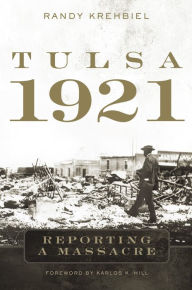-
[Pdf/ePub] Tulsa, 1921: Reporting a Massacre by Randy Krehbiel, Karlos K. Hill download ebook
Tulsa, 1921: Reporting a Massacre. Randy Krehbiel, Karlos K. Hill

Tulsa-1921-Reporting-a.pdf
ISBN: 9780806168715 | 328 pages | 9 Mb

- Tulsa, 1921: Reporting a Massacre
- Randy Krehbiel, Karlos K. Hill
- Page: 328
- Format: pdf, ePub, fb2, mobi
- ISBN: 9780806168715
- Publisher: University of Oklahoma Press
Download Tulsa, 1921: Reporting a Massacre
Books pdf for free download Tulsa, 1921: Reporting a Massacre by Randy Krehbiel, Karlos K. Hill DJVU
In 1921 Tulsa’s Greenwood District, known then as the nation’s “Black Wall Street,” was one of the most prosperous African American communities in the United States. But on May 31 of that year, a white mob, inflamed by rumors that a young Black man had attempted to rape a white teenage girl, invaded Greenwood. By the end of the following day, thousands of homes and businesses lay in ashes, and perhaps as many as three hundred people were dead. Tulsa, 1921 shines new light into the shadows that have long been cast over this extraordinary instance of racial violence. With the clarity and descriptive power of a veteran journalist, author Randy Krehbiel digs deep into the events and their aftermath and investigates decades-old questions about the local culture at the root of what one writer has called a white-led pogrom. Krehbiel analyzes local newspaper accounts in an unprecedented effort to gain insight into the minds of contemporary Tulsans. In the process he considers how the Tulsa World, the Tulsa Tribune, and other publications contributed to the circumstances that led to the disaster and helped solidify enduring white justifications for it. Some historians have dismissed local newspapers as too biased to be of value for an honest account, but by contextualizing their reports, Krehbiel renders Tulsa’s papers an invaluable resource, highlighting the influence of news media on our actions in the present and our memories of the past. The Tulsa Massacre was a result of racial animosity and mistrust within a culture of political and economic corruption. In its wake, Black Tulsans were denied redress and even the right to rebuild on their own property, yet they ultimately prevailed and even prospered despite systemic racism and the rise during the 1920s of the second Ku Klux Klan. As Krehbiel considers the context and consequences of the violence and devastation, he asks, Has the city—indeed, the nation—exorcised the prejudices that led to this tragedy?
Tulsa, 1921: Reporting a Massacre by Randy Krehbiel
Tulsa, 1921: Reporting a Massacre by Randy Krehbiel. $21.95. In 1921 Tulsa's Greenwood District, known then as the nation's “Black Wall Street,” was one of Tulsa 1921: Reporting a Massacre by Randy Krehbiel
Tulsa 1921: Reporting a Massacre. By Randy Krehbiel. Foreword by Karlos K. Hill. (Norman: University of Oklahoma Press, 2019. Pp. xviii, 309. Tulsa 1921: Reporting a Massacre (Audible - Amazon.com
Amazon.com: Tulsa 1921: Reporting a Massacre (Audible Audio Edition): Randy Krehbiel, Kevin Meyer, University Press Audiobooks: Audible Audiobooks. Tulsa 1921: Reporting a Massacre (Unabridged) on Apple
In 1921, Tulsa's Greenwood District - known then as the nation's “Black Wall Street” - was one of the most prosperous African American communities in the Tulsa Race Massacre Focus of TCC Common Book Selection
With a focus on the Tulsa Race Massacre and the 100th commemoration, Tulsa Community College adopted “Tulsa 1921: Reporting a Tulsa, 1921: Reporting a Massacre (Paperback) | Watermark
In 1921 Tulsa's Greenwood District, known then as the nation's "Black Wall Street," was one of the most prosperous African American Tulsa, 1921: Reporting a Massacre (Paperback) | Vroman's
In 1921 Tulsa's Greenwood District, known then as the nation's "Black Wall Street," was one of the most prosperous African American Tulsa, 1921: Reporting a Massacre by Randy Krehbiel
In 1921 Tulsa's Greenwood District, known then as the nation's “Black Wall Street,” was one of the most prosperous African American Tulsa, 1921 - University of Oklahoma Press
EQUAL OPPORTUNITY INSTITUTION. WWW.OU.EDU/EOO. OUPRESS.COM CONNECT WITH US for immediate release. Tulsa, 1921. Reporting a Massacre. Tulsa, 1921: Reporting a Massacre (Paperback) | Sandman
In 1921 Tulsa's Greenwood District, known then as the nation's "Black Wall Street," was one of the most prosperous African American The 1921 Tulsa Massacre | The National Endowment for the
Randy Krehbiel's Tulsa 1921: Reporting a Massacre quotes Washington Irving's 1835 eyewitness description of the Creeks, which confirms an early Black The Case for Reparations in Tulsa, Oklahoma | Human Rights
These include the 2001 “Tulsa Race Riot Report,” numerous books on the massacre and its aftermath, news articles, law review articles, Why President Trump's choice of Tulsa for his latest rally is
In the 1990s, Oklahoma put together a commission to try to find out what happened in the 1921 massacre, and in 2001, it released a report on its Tulsa, 1921: Reporting a Massacre - Bookshop
In 1921 Tulsa's Greenwood District, known then as the nation's "Black Wall Street," was one of the most prosperous African American communities in the Opinion | The Tulsa Race Massacre, Revisited - The New York
A 2001 report on the destruction commissioned by the Oklahoma State Legislature included a photograph of Greenwood burning. The telling,More eBooks:
{pdf descargar} EL EXTRAÑO VERANO DE TOM HARVEY
[ePub] BURLINGTON INTERNATIONAL ENGLISH B1 (WORKBOOK) descargar gratis
[Pdf/ePub/Mobi] EN BUSCA DEL BARON CORVO: UN EXPERIMENTO BIOGRAFICO - A.J.A. SYMONS descargar ebook gratis
-
Commentaires
